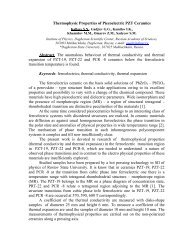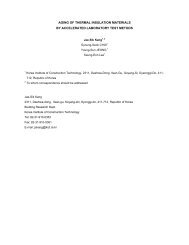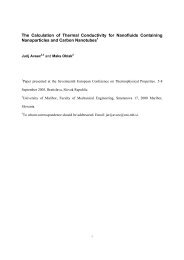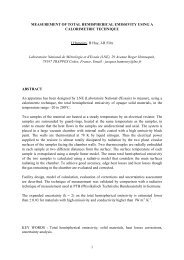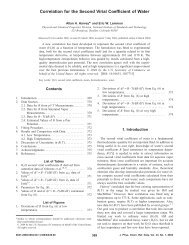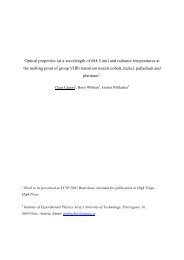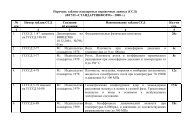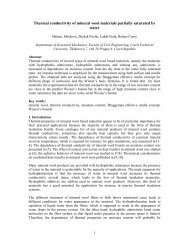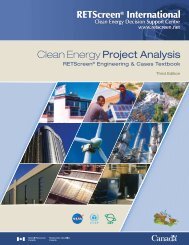Properties of alkali activated aluminosilicate ... - thermophysics.ru
Properties of alkali activated aluminosilicate ... - thermophysics.ru
Properties of alkali activated aluminosilicate ... - thermophysics.ru
Create successful ePaper yourself
Turn your PDF publications into a flip-book with our unique Google optimized e-Paper software.
Table 6 shows that the dependence <strong>of</strong> mechanical properties on heating temperature was not<br />
monotonic as it is usual for many other building materials. Both compressive strength and<br />
bending strength achieved their minimum values at 800 0 C where compressive strength was<br />
about 5 times and bending strength 2.5 times lower than for reference specimens, and then<br />
they began to increase. After heating to 1200 0 C, the compressive strength was only by about<br />
12% lower and the bending strength by 18% lower than those <strong>of</strong> reference specimens.<br />
Table 7 Thermal properties <strong>of</strong> dry material in dependence on thermal load<br />
Thermal load [ 0 C] Thermal conductivity<br />
[W/mK]<br />
Specific heat<br />
capacity [J/kgK]<br />
Thermal diffusivity<br />
[10 -6 m 2 /s]<br />
25 1.59 798 0.92<br />
200 1.60 781 0.99<br />
400 1.67 743 1.04<br />
600 1.09 754 0.70<br />
800 0.94 777 0.59<br />
1000 1.10 789 0.67<br />
1200 1.16 738 0.77<br />
The effect <strong>of</strong> heating temperature on thermal conductivity <strong>of</strong> the studied <strong>aluminosilicate</strong><br />
material in dry state is presented in Table 7. Similarly as with the porosity and the<br />
mechanical properties, the first remarkable change was observed for the heating to 600 0 C. The<br />
thermal conductivity decreased here by about 30% in comparison with the reference material<br />
and the decrease continued at 800 0 C where it achieved about 40%. For higher heating<br />
temperatures, the thermal conductivity was stabilized approximately on the values measured<br />
for 600 0 C heating.<br />
3,5<br />
3,0<br />
thermal conductivity [Wm -1 K -1 ]<br />
2,5<br />
2,0<br />
1,5<br />
1,0<br />
0,5<br />
200 C<br />
400 C<br />
600 C<br />
800 C<br />
1000 C<br />
1200 C<br />
25 C<br />
0,0<br />
0,00 0,02 0,04 0,06 0,08 0,10<br />
moisture content [kgkg -1 ]<br />
Fig. 2 Thermal conductivity <strong>of</strong> the studied material in dependence on moisture content and<br />
thermal load<br />
6



